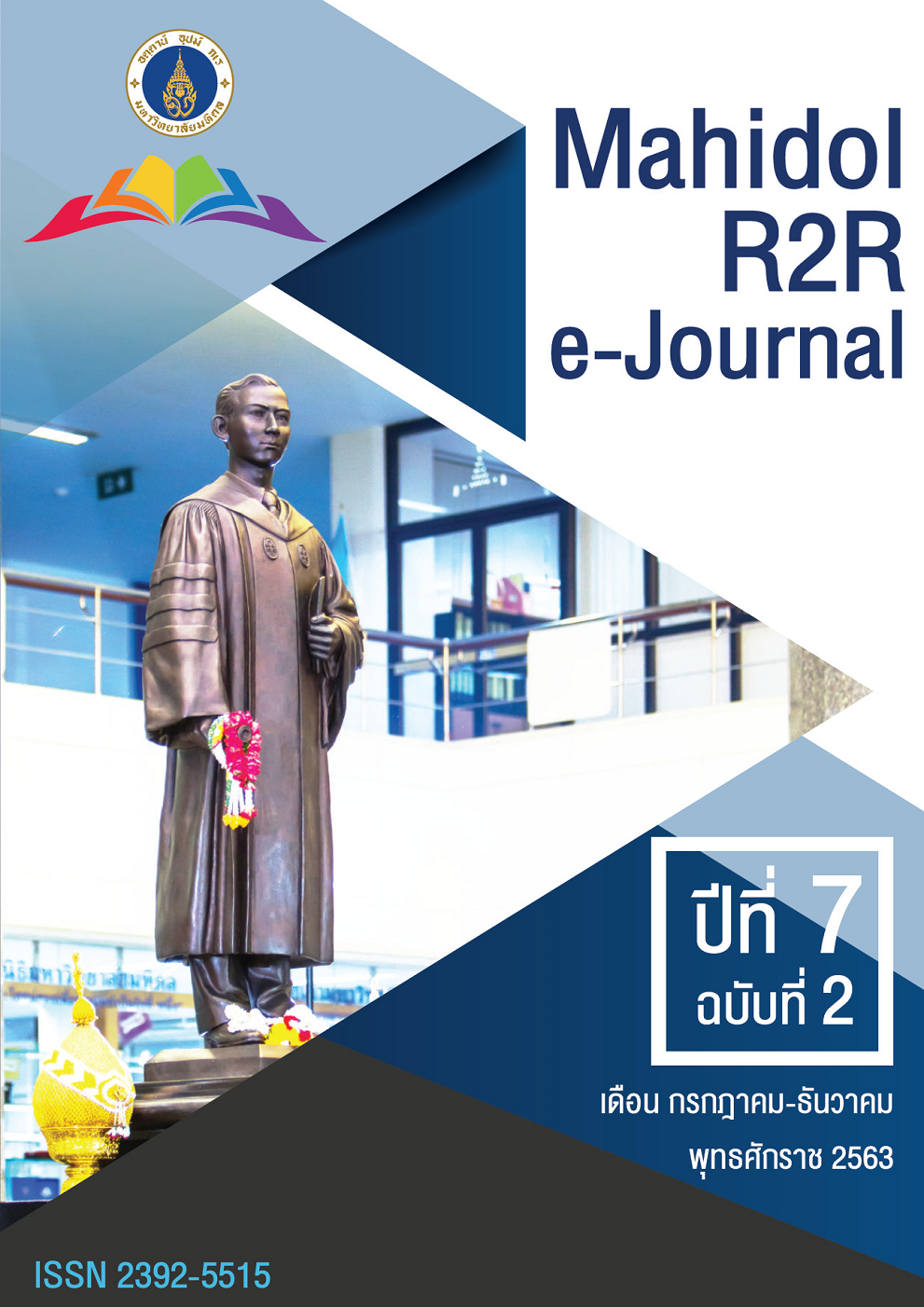การประยุกต์ใช้คะแนนประเมินภาวะเลือดออกชนิดครูเซดกับการเกิดภาวะเลือดออก ชั้นใต้ผิวหนังชนิดมีก้อน
DOI:
https://doi.org/10.14456/jmu.2020.18คำสำคัญ:
เลือดออกชั้นใต้ผิวหนังชนิดมีก้อน, คะแนนประเมินภาวะเลือดออกชนิดครูเซดบทคัดย่อ
ภาวะแทรกซ้อนเลือดออกชั้นใต้ผิวหนังชนิดมีก้อน เป็นสิ่งที่พบได้บ่อยในผู้ป่วยที่ได้รับการสวนหัวใจ การศึกษานี้มีวัตถุประสงค์เพื่อศึกษาความสัมพันธ์ของแบบประเมินภาวะเลือดออกครูเซดกับการเกิดเลือดออกชั้นใต้ผิวหนังชนิดมีก้อน ในผู้ป่วยภาวะกล้ามเนื้อหัวใจขาดเลือดเฉียบพลันที่ได้รับการสวนหัวใจ และถอดสายสวนหัวใจที่ขาหนีบ จำนวน 45 ราย ผลการศึกษาพบว่า คะแนนประเมินภาวะเลือดออกชนิดครูเซดมีความสัมพันธ์กับการเกิดเลือดออกชั้นใต้ผิวหนังชนิดมีก้อน (p=0.04) ภาวะแทรกซ้อนเลือดออกชั้นใต้ผิวหนังชนิดมีก้อนเป็นสิ่งที่พบได้บ่อย การป้องกันภาวะแทรกซ้อนเป็นสิ่งจำเป็นเพื่อความปลอดภัยของผู้ป่วย
เอกสารอ้างอิง
Ando, G.,& Costa, F. (2015). Bleeding risk stratification in acute coronary syndromes. Is it still valid in the era of the radial approach? Advances in interventional cardiology, 11(3):170–3.
Assi, E.A., Roubin, S.R., Lear, P., Grandio, P.C., Girondo, M., Cordero, M.R.,…Juanatey, R.G. (2012). Comparing the predictive validity of three contemporary bleeding risk scores in acute coronary syndrome. European Heart Journal: Acute Cardiovascular Care, 1(3): 222–31.
Bentoa, D., Marquesa, N., Azevedoa, P., Guedesa, J., Bispoa, J., Silva, D.,…Jesusa ,I.D. (2018). CRUSADE: Is it still a good score to predict bleeding in acute coronary syndrome?. Revista Portuguesa de Cardiologia,37(11):889-97.
Choussat, R., Black, A., Bossi, I., Fajadet, J., &Marco, J. (2000). Vascular complications and clinical outcome after coronary angioplasty with platelet IIb/IIIa receptor blockade. Comparison of transradial vs transfemoral arterial access. European Heart Journal, 21: 662–67.
Dandecha, B., & Chalernsin, C. (2011). A comparison of efficiency and safety of femoral artery hemostasis after coronary angiography between manual compression and mechanical compression. Journal of Health Science and Medical Research, 29(2), 51
Daydamony, M.M., & Farag, E.S. (2016). CRUSADE bleeding score as a predictor of bleeding events in patients with acute coronary syndrome in Zagazig university hospital. Indian Heart Journal, 68, 632-638.
Ebeedc, M., Khalil, N.S., & Ismaeel, M.S. (2017). Vascular complications and risk factors among patients undergoing cardiac catheterization. Egyptian Nursing Journal, 14, 259-268.
Heywood, C., Huang, M., Bober, W., & Raio, C. Ultrasound-assisted compression of the femoral artery in a hypotensive patient with expanding hematoma post cardiac catheterization. Internal and Emergency Medicine, 2(2),1-3.
Hoke, L.M., Ratcliffe, S.J., Kimmel, S.E., Kolansky, D.M., & Polomano, R. (2010). Predictors of complications following sheath removal with percutaneous coronary intervention. The Journal of cardiovascular nursing, 25(3),1-8.
Huffman, C., Torguson, R., Fatemi, O., Chen, F., Gai, J., Suddath, W.,…Waksman, R. (2015). Comparison of bleeding outcomes after percutaneous coronary intervention in patients with versus without aortic stenosis. The American journal of cardiology, 116:1106-9.
Hung, F.S., Jaafar, S., Misra S., & Narasimha, V. (2019). Scrotal hematoma with pseudo-aneurysm after transfemoral catheterization. International Journal of Surgery Case Reports, 2,1–4.
Hoke, L.M., Ratcliffe, S.J., Kimmel, S.E., Kolansky, D.M., & Polomano, R. (2010). Predictors of complications following sheath removal with percutaneous coronary intervention. The Journal of cardiovascular nursing, 25(3),1-8.
Jomjang, S., & Namjuntra, R. (2017). Factors related to the occurrence of vascular complications among patients receiving percutaneous coronaryinterventions via the femoral artery. APHEIT International Journal, 6(2),14-24.
Kassem, H.H., Elmahdy, M.F., Ewis, E.B., & Mahdy, S.G. (2013). Incidence and predictors of post-catheterization femoral artery pseudoaneurysms. The Egyptian Heart Journal, 6, 213-221.
Merriweather, N., & Sulzbach-Hoke, L.M. (2012). Managing risk of complications at femoral vascular access sites in percutaneous coronary intervention. Critical Care Nursing Journal, 32(5), 1-14.
Numasawa, Y., Kohsaka, S., Ueda, I., Miyata, H., Sawano, M., Kawamura, A., …Fukuda, K. (2017). Incidence and predictors of bleeding complications after percutaneous coronary intervention. International Journal of Cardiology, 69, 272-279.
Patricia, M.S., Sheila, R.R., Faye, C.C., & Sonya, R.H. (2013). Factors associated with groin complications post coronary intervention. Journal of Clinical Nursing, 1(1),26-34.
Rao, S.V., Mccoy, L.A., Spertus, J.A., Krone, R.J., Singh, M., Fitzgerald, S.,…Peterson, E.D. (2013). An updated bleeding model to predict the risk of post-procedure bleeding among patients undergoing percutaneous coronary intervention :A report using an expanded bleeding definition from the national cardiovascular data registry cath PCI registry. JACC: Cardiovascular Interventions, 6(9),897-904.
Sattur, S., Harjai, K.J., Narula, A., Devarakonda, S., Orshaw, P., & Yaeger, K. (2009). The Influence of anemia after percutaneous coronary intervention on clinical outcomes. The clinical cardiology journal, 32(7), 373 - 379.
Yildirim, E., Uku,O., Bilen, M.N., & Secen, O. (2019). Performance of HAS-BLED and CRUSADE risk score for the prediction of haemorrhagic events in patients with stable coronary artery disease. The Cardiovascular Journal of Africa,1-5.
Zhao, X.Y., Li, J.X., Tang, X.F., Xian, Y., Xu, J.J., Song, Y.,…Yuan, J.Q. (2018). Evaluation of CRUSADE and ACUITY‑HORIZONS scores for predicting long-term out-of-hospital bleeding after percutaneous coronary interventions. Chinese medical journal, 13(5):262-7.
ดาวน์โหลด
เผยแพร่แล้ว
ฉบับ
ประเภทบทความ
สัญญาอนุญาต




